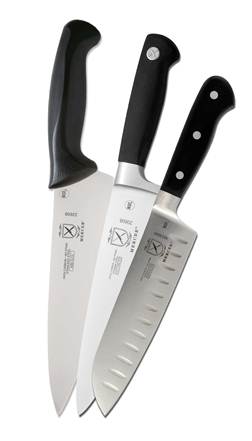50-Minute Classroom: How to Buy Knives, Part 2
31 October 2010By Adam Weiner
 Chef Weiner continues his advice for students on selecting and maintaining knives. This month: the difference between sharpening and honing and the definition of “true.”
Chef Weiner continues his advice for students on selecting and maintaining knives. This month: the difference between sharpening and honing and the definition of “true.”
Last month’s article was a handout for your students on how to buy knives. This month I am giving you a handout on how to hone and sharpen knives. Next month will be on using knives, and then the fourth article will cover how to care for knives. So, cut out the below and give it to your students as part two of a four-part series on knives:
Many new cooks confuse sharpening knives with honing knives. They are not the same thing. Honing a knife puts the edge back into “true,” while sharpening a knife removes part of the metal and creates a new edge.
If you look under a microscope at a knife, you will see a lot of thin teeth, kind of like one of those cheap plastic combs. Through use and washing, the teeth get pushed out of alignment, out of true. The purpose of the steel is to bring the teeth of the knife back into alignment, back into true. If the end of the teeth becomes dull because of a lot of use or abuse, then aligning it with a steel will not help, and the knife will need to be sharpened instead.
The next question becomes whether to sharpen the knife yourself, use a gizmo as seen on TV, or have a professional do it.
Sharpening a knife yourself requires using three different sharpening stones. It takes a lot of time, a lot of knowledge and a lot of elbow grease. In other words, you cannot properly and professionally sharpen your knives personally unless you spend hours with oil and three different sharpening stones. Very few chefs sharpen their own knives anymore.
You cannot properly sharpen your knives with a gizmo from the store, the Internet or a catalog. These will ruin your knives and won’t sharpen them.
The best way to correctly sharpen a knife is taking it to a professional sharpening service that specializes in chefs’ knives. If the place also does lawn-mower blades and hedge trimmers, take your knives and run out of the store. If you cannot find one in your area, then check the Internet and send your knives off. I personally use Perfect Edge Cutlery in California. Depending on how often you use a knife, it will need to be professionally sharpened at least twice a year.
Now for honing your knife: Every time you reach for a knife—other than a bread knife—from your bag or off the rack, you should use steel. To learn how to properly use steel, ask someone knowledgeable to show you. This really is one of those skills where you have to work one-on-one with someone who knows what she/he is doing.
However, here are a few pointers:
- Hold the knife in your right hand if you are right-handed and the steel in your left. Keep the steel rigid. You move the knife, not the steel.
- Starting at the bottom of the knife blade, make a pretend slice using the whole blade of the knife, from bottom to top holding the knife at an angle on the steel. To get the desired angle, hold the knife perpendicular to the steel (a 90-degree angle) then cut the angle in half (45 degrees) and cut that in half again (approximately 22 degrees).
- Do this about five or six times on each side. Then four times each side, then two, then one. Always do the same number on each side.
- Don’t go fast like you see butchers do in the market. There is no prize for doing it fast.
- Always keep your eyes on your fingers while doing this. Don’t look at anything or anyone else in the kitchen while honing a knife.
Again, EVERY TIME, EVERY TIME, EVERY TIME you wash a knife, take a knife out of a rack or take it out of your knife kit, you should use steel on it. The only exception is a bread knife. If you don’t, you are showing the chef two things: (1) You don’t mind cutting yourself. If you don’t use a steel, your knife will lack a precise edge, which means it is more likely to slip. (2) You like to work harder than necessary. If you use the steel, the more precise edge will make your knife cut easier and faster.
Next month, for part three, we will cover how to use a knife.
Chef Adam Weiner teaches a 20-week Introduction to Cooking program for JobTrain and the Sequoia Adult School on the San Francisco Peninsula.
